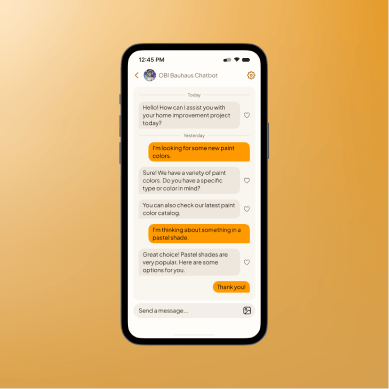Redefining Customer Support for OBI with AI-Driven Chatbots
Discover how we conceptualized a chatbot that transforms the DIY experience for a tech-savvy audience, using the Branded Interaction Framework.

Features
Discover how we conceptualized a chatbot that transforms the DIY experience for a tech-savvy audience, using the Branded Interaction Framework.
Limited After-Hours Support
Customers needed help beyond traditional business hours.
Inconsistent Communication
Disjointed messaging diluted the brand experience.
High Volume of Inquiries
Manual responses weren’t scalable.
Stats
Process
Discover
Analyzed competitors like Hornbach and Bauhaus. Mapped OBI’s brand identity with Brand Filters and Limbic Maps. Created personas like 'The DIY Enthusiast' to align with target users.
Define
Identified gaps in customer support. Crafted a chatbot persona aligned with OBI’s values. Mapped conversational flows using Miro.
Ideate
Developed story maps to visualize the user journey. Ensured scalability for future use cases like DIY guides and voice integration.
Prototype & Test
Created interactive prototypes and conducted usability testing with target user groups.
Design Elements
User-Centered Design
Personas and customer journeys ensured usability for OBI’s tech-savvy customers.
Brand Alignment
Reflects OBI’s approachable, innovative identity through tone and visuals.
Seamless Integration
Real-time connections to product databases and customer profiles.
Future-Proof Scalability
Designed to adapt for voice assistance and in-store deployment.
Outcomes
Insights
Biggest Challenge
Aligning user needs, business goals, and technological capabilities.
Frameworks Shaped the Concept
Tools like Limbic Maps and Value Proposition Canvas provided structure and clarity.
Collaboration Lessons
Diverse brand analyses revealed opportunities to innovate in the market.
Service Design Understanding
Reinforced the value of designing services that are both functional and emotionally engaging.
FAQs
What was the main goal of the OBI Chatbot project?
To conceptualize an AI-driven chatbot that transforms the DIY experience for OBI’s tech-savvy customers, using the Branded Interaction Framework.
What was the biggest challenge?
Aligning user needs, business goals, and technological capabilities.
How did frameworks shape the concept?
Frameworks like Limbic Maps and Value Proposition Canvas provided structure and clarity to the design process.
What did collaboration teach the team?
Diverse brand analyses and teamwork revealed new opportunities for innovation in customer support.
How did this project influence your understanding of service design?
It reinforced the value of designing services that are both functional and emotionally engaging.